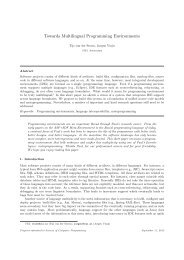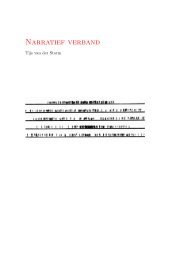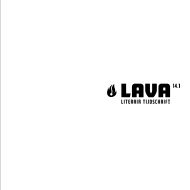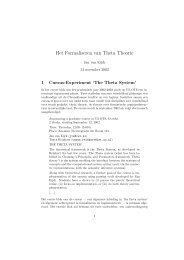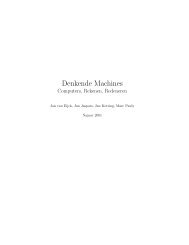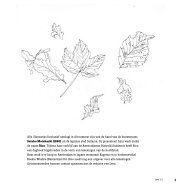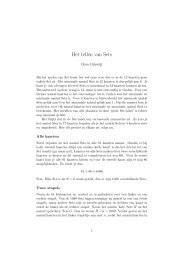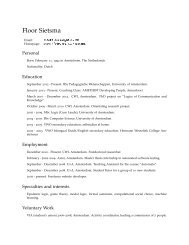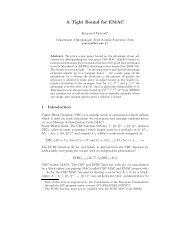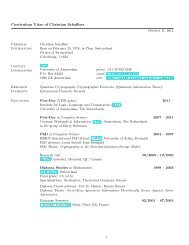Download this paper in pdf format - CWI
Download this paper in pdf format - CWI
Download this paper in pdf format - CWI
You also want an ePaper? Increase the reach of your titles
YUMPU automatically turns print PDFs into web optimized ePapers that Google loves.
Deformable image registration by multi-objective optimization us<strong>in</strong>g a<br />
dual-dynamic trans<strong>format</strong>ion model to account for large anatomical<br />
differences<br />
Tanja Alderliesten a , Jan-Jakob Sonke a , Peter A.N. Bosman b<br />
a<br />
Dept. of Radiation Oncology, The Netherlands Cancer Institute – Antoni van Leeuwenhoek<br />
Hospital (NKI-AVL), P.O. Box 90203, 1006 BE Amsterdam, The Netherlands;<br />
b<br />
Centrum Wiskunde & In<strong>format</strong>ica (<strong>CWI</strong>), P.O. Box 94079, 1090 GB Amsterdam, The Netherlands<br />
ABSTRACT<br />
Some of the hardest problems <strong>in</strong> deformable image registration are problems where large anatomical differences occur<br />
between image acquisitions (e.g. large de<strong>format</strong>ions due to images acquired <strong>in</strong> prone and sup<strong>in</strong>e positions and<br />
(dis)appear<strong>in</strong>g structures between image acquisitions due to surgery). In <strong>this</strong> work we developed and studied, with<strong>in</strong> a<br />
previously <strong>in</strong>troduced multi-objective optimization framework, a dual-dynamic trans<strong>format</strong>ion model to be able to tackle<br />
such hard problems. This model consists of two non-fixed grids: one for the source image and one for the target image.<br />
By not requir<strong>in</strong>g a fixed, i.e. pre-determ<strong>in</strong>ed, association of the grid with the source image, we can accommodate for<br />
both large de<strong>format</strong>ions and (dis)appear<strong>in</strong>g structures. To f<strong>in</strong>d the trans<strong>format</strong>ion that aligns the source with the target<br />
image we used an advanced, powerful model-based evolutionary algorithm that exploits features of a problem’s structure<br />
<strong>in</strong> a pr<strong>in</strong>cipled manner via probabilistic model<strong>in</strong>g. The actual trans<strong>format</strong>ion is given by the association of coord<strong>in</strong>ates<br />
with each po<strong>in</strong>t <strong>in</strong> the two grids. L<strong>in</strong>ear <strong>in</strong>terpolation <strong>in</strong>side a simplex was used to extend the correspondence (i.e.<br />
trans<strong>format</strong>ion) as found for the grid to the rest of the volume. As a proof of concept we performed tests on both artificial<br />
and real data with disappear<strong>in</strong>g structures. Furthermore, the case of prone-sup<strong>in</strong>e image registration for 2D axial slices of<br />
breast MRI scans was evaluated. Results demonstrate strong potential of the proposed approach to account for large<br />
de<strong>format</strong>ions and (dis)appear<strong>in</strong>g structures <strong>in</strong> deformable image registration.<br />
Keywords: Multi-objective optimization, evolutionary algorithms, deformable registration, large anatomical differences<br />
1. INTRODUCTION<br />
Exist<strong>in</strong>g deformable image registration methods (e.g. solely us<strong>in</strong>g biomechanical model-based or non-rigid <strong>in</strong>tensitybased<br />
image registration methods) have limited success when large anatomical differences are <strong>in</strong>volved. A hybrid<br />
method that was recently <strong>in</strong>troduced proved to be more successful but reported registration accuracies were still not very<br />
good. 1 Further, so far, only a few studies addressed the issue of disappear<strong>in</strong>g structures (e.g. due to tissue excision<br />
between image acquisitions). 2-7 Moreover, <strong>in</strong> these works the identification of the disappear<strong>in</strong>g structures is considered a<br />
separate task, often as part of segmentation. Furthermore, when the focus is on <strong>in</strong>tra-operative guidance, the assumption<br />
is used that disappeared tissue has been replaced by “air”. 7 This will, however, not always be the case. For example <strong>in</strong><br />
the case of breast-conserv<strong>in</strong>g surgery for breast cancer, the excision cavity is often closed for an improved cosmetic<br />
result. Post-surgery radiotherapy is subsequently planned on a CT scan acquired after surgery s<strong>in</strong>ce <strong>this</strong> is most<br />
representative for the anatomy to be treated, mak<strong>in</strong>g it, however, difficult to def<strong>in</strong>e the orig<strong>in</strong>al tumor position (Figure 1).<br />
Radiotherapy plann<strong>in</strong>g could benefit extremely from deformable registration of pre- and post-operative imag<strong>in</strong>g data.<br />
We recently <strong>in</strong>troduced the concept of multi-objective optimization for deformable image registration. 8 The rationale is<br />
that such an approach removes the need for a predeterm<strong>in</strong>ed s<strong>in</strong>gular comb<strong>in</strong>ation of objectives. By comput<strong>in</strong>g and<br />
present<strong>in</strong>g multiple outcomes that represent efficient trade-offs between the objectives (a so-called Pareto front) at once,<br />
____________________________________<br />
Further author <strong>in</strong><strong>format</strong>ion:<br />
T.A.: E-mail: t.alderliesten@nki.nl, Telephone: +31 (0)20 512 1706<br />
J.-J.S.: E-mail: j.sonke@nki.nl, Telephone: +31 (0)20 512 1723<br />
P.A.N.B.: E-mail: Peter.Bosman@cwi.nl, Telephone: +31 (0)20 592 4238<br />
Medical Imag<strong>in</strong>g 2013: Image Process<strong>in</strong>g, edited by Sebastien Oursel<strong>in</strong>, David R. Haynor,<br />
Proc. of SPIE Vol. 8669, 866910 · © 2013 SPIE · CCC code: 1605-7422/13/$18<br />
doi: 10.1117/12.2006783<br />
Proc. of SPIE Vol. 8669 866910-1<br />
<strong>Download</strong>ed From: http://proceed<strong>in</strong>gs.spiedigitallibrary.org/ on 04/22/2013 Terms of Use: http://spiedl.org/terms
f-- tumor<br />
- Target volume for irradiation<br />
- Expanded with safety marg<strong>in</strong>s<br />
Post -operative CT<br />
Figure 1. Left and middle: Pre- and post-operative breast CT scan example slices. Right: pre- and post-operative CT scan<br />
after rigid registration based on the ribs.<br />
<strong>this</strong> approach allows for more <strong>in</strong>sightful tun<strong>in</strong>g of the manner <strong>in</strong> which to comb<strong>in</strong>e important objectives <strong>in</strong> deformable<br />
image registration such as trans<strong>format</strong>ion effort and similarity measure.<br />
F<strong>in</strong>d<strong>in</strong>g optimal solutions, i.e. the optimal Pareto front of all non-dom<strong>in</strong>ated solutions, to high-dimensional multiobjective<br />
optimization problems is a non-trivial task. In practice, the goal is therefore often to f<strong>in</strong>d high-quality<br />
approximations of the optimal Pareto front. To f<strong>in</strong>d such high-quality approximations, we used a particular type of<br />
evolutionary algorithm, known as EDA (Estimation-of-Distribution Algorithm) which aims to exploit features of a<br />
problem’s structure automatically <strong>in</strong> a pr<strong>in</strong>cipled manner via probabilistic model<strong>in</strong>g. 9-12 Moreover, we recently studied<br />
the use of a new variant of the EDA that we previously employed. This new variant has the advantage of converg<strong>in</strong>g<br />
faster while obta<strong>in</strong><strong>in</strong>g solutions of the same quality. 13 This allows us to use more f<strong>in</strong>e-gra<strong>in</strong>ed grids (that have more<br />
variables to be optimized) for the registration task, which is of importance for more complex registration tasks,<br />
especially when consider<strong>in</strong>g disappear<strong>in</strong>g structures.<br />
In <strong>this</strong> <strong>paper</strong>, we developed and studied, with<strong>in</strong> the previously <strong>in</strong>troduced multi-objective optimization framework, a<br />
dual-dynamic trans<strong>format</strong>ion model. We propose to consider the challeng<strong>in</strong>g problem of identify<strong>in</strong>g (dis)appear<strong>in</strong>g<br />
structures to be part of the overall optimization process, thereby lett<strong>in</strong>g the optimization algorithm decide and identify,<br />
us<strong>in</strong>g the dual-dynamic trans<strong>format</strong>ion model, which parts are most likely to have (dis)appeared, all at once dur<strong>in</strong>g the<br />
registration process.<br />
2. MATERIALS AND METHODS<br />
2.1 Dual dynamic trans<strong>format</strong>ion model<br />
Image registration is the process that determ<strong>in</strong>es the trans<strong>format</strong>ion that maps po<strong>in</strong>ts <strong>in</strong> the source image to<br />
correspond<strong>in</strong>g po<strong>in</strong>ts <strong>in</strong> the target image. The trans<strong>format</strong>ion model, i.e. the representation of possible trans<strong>format</strong>ions is<br />
often based on a regular grid of po<strong>in</strong>ts. The actual trans<strong>format</strong>ion then is given by the association of coord<strong>in</strong>ates with<br />
each po<strong>in</strong>t <strong>in</strong> the grid. A means of <strong>in</strong>terpolation is required to extend the so-established correspondence between grids to<br />
create the transformed source image. The number of real-valued parameters to be optimized equals the number of grid<br />
po<strong>in</strong>ts (n g ) times the spatial dimensionality of the image (e.g., n g ×2 for a 2-dimensional image).<br />
Instead of a fixed grid for the source image and a non-fixed grid for the target image, we will use two non-fixed irregular<br />
grids: one for the source image and one for the target image. No longer requir<strong>in</strong>g a fixed, i.e. pre-determ<strong>in</strong>ed, association<br />
of the grid with the source image provides the potential to correlate the grid <strong>in</strong> the source image better with underly<strong>in</strong>g<br />
image structures. Moreover, both disappear<strong>in</strong>g and appear<strong>in</strong>g structures can be accommodated. Specifically, the location<br />
of each grid po<strong>in</strong>t <strong>in</strong> both target and source images can now be determ<strong>in</strong>ed. To make a structure disappear, the grid<br />
po<strong>in</strong>ts that <strong>in</strong> the source image del<strong>in</strong>eate a structure that has disappeared can be placed on top of each other <strong>in</strong> the grid <strong>in</strong><br />
the target image. Conversely, to make a structure appear, grid po<strong>in</strong>ts that <strong>in</strong> the target image del<strong>in</strong>eate a structure that has<br />
appeared can be placed on top of each other <strong>in</strong> the source grid. In <strong>this</strong> pilot study, however, we restrict ourselves to<br />
disappear<strong>in</strong>g structures.<br />
Proc. of SPIE Vol. 8669 866910-2<br />
<strong>Download</strong>ed From: http://proceed<strong>in</strong>gs.spiedigitallibrary.org/ on 04/22/2013 Terms of Use: http://spiedl.org/terms
In <strong>this</strong> <strong>paper</strong>, l<strong>in</strong>ear <strong>in</strong>terpolation <strong>in</strong>side a simplex after grid triangulation was used to extend the correspondence between<br />
grids (i.e. trans<strong>format</strong>ion) as found for the grid po<strong>in</strong>ts to the rest of the volume to create the transformed source image.<br />
An advantage of <strong>this</strong> choice is that it can cope with non-convex grid elements.<br />
2.2 Registration as an optimization problem<br />
The task of deformable image registration, i.e. the process of align<strong>in</strong>g a source image with a target image, can be well<br />
posed as an optimization problem. For the task of image registration two issues are of prime <strong>in</strong>terest. 1) Quality of fit:<br />
<strong>in</strong>tensity similarity, i.e. the degree of similarity between <strong>in</strong>tensity patterns <strong>in</strong> the target image and the transformed source<br />
image. 2) Smoothness of de<strong>format</strong>ion: trans<strong>format</strong>ion effort, i.e., the amount of energy required to accomplish the<br />
trans<strong>format</strong>ion.<br />
Our methodology can be comb<strong>in</strong>ed with state-of-the-art similarity measures and de<strong>format</strong>ion models. The ma<strong>in</strong> purpose<br />
of <strong>this</strong> study, however, was to observe the feasibility of us<strong>in</strong>g the dual-dynamic grid trans<strong>format</strong>ion model <strong>in</strong> order to<br />
tackle large de<strong>format</strong>ions and (dis)appear<strong>in</strong>g structures all at once. Therefore, <strong>in</strong> the follow<strong>in</strong>g we provide rudimentary,<br />
but computationally useful models. We model similarity <strong>in</strong> <strong>in</strong>tensity with a measure (to be m<strong>in</strong>imized) that is def<strong>in</strong>ed as<br />
the sum of the squared differences <strong>in</strong> grey value between the target image and the transformed source image. The<br />
trans<strong>format</strong>ion effort is modeled by the use of Hooke’s law. 14 The required energy to perform a trans<strong>format</strong>ion is<br />
computed on the basis of changes <strong>in</strong> the lengths of edges <strong>in</strong> the grid. For <strong>this</strong> purpose and to ensure that various shape<br />
changes result <strong>in</strong> an <strong>in</strong>crease <strong>in</strong> required energy, all possible comb<strong>in</strong>ations between corner po<strong>in</strong>ts, po<strong>in</strong>ts halfway on a<br />
grid l<strong>in</strong>e, and comb<strong>in</strong>ations between corner po<strong>in</strong>ts and po<strong>in</strong>ts halfway on a gridl<strong>in</strong>e are considered (Figure 2). Now, if we<br />
denote the set of considered edges by E, we can def<strong>in</strong>e total energy U total-deform to be m<strong>in</strong>imized as follows:<br />
before after<br />
( e − e ) 2<br />
1<br />
U<br />
deform(<br />
e)<br />
= l<br />
,<br />
e<br />
U<br />
total − deform<br />
= ∑U<br />
deform<br />
( e)<br />
2<br />
e∈E<br />
where l e is an elasticity constant associated with the tissue that edge e crosses.<br />
2.3 Optimization algorithm<br />
The underly<strong>in</strong>g optimization problem <strong>in</strong> practice is multi-objective, i.e. f<strong>in</strong>d trans<strong>format</strong>ions that on the one hand<br />
maximize the similarity between source and target image (objective 1) and on the other hand m<strong>in</strong>imize the amount of<br />
required energy (objective 2). In multi-objective optimization, the optimum is a set of solutions, called the optimal Pareto<br />
front, because many solutions may be equally good, e.g. solution a may be better <strong>in</strong> the first objective than solution b,<br />
but worse <strong>in</strong> the second objective. Therefore, a collection of outcomes (a so-called Pareto front) that represents efficient<br />
trade-offs between the objectives is computed and presented at once.<br />
1/1/ / L 1Ì Ì /Ì 1Ì<br />
1Ì/Ì1Ì<br />
1Ì/Ì1Ì<br />
1Ì/Ì1Ì<br />
Figure 2. Left: Grid of po<strong>in</strong>ts used as a basis for the trans<strong>format</strong>ion model. Right: Grid of po<strong>in</strong>ts with all connections taken<br />
<strong>in</strong>to account <strong>in</strong> the calculation of the required energy to accomplish the trans<strong>format</strong>ion.<br />
Proc. of SPIE Vol. 8669 866910-3<br />
<strong>Download</strong>ed From: http://proceed<strong>in</strong>gs.spiedigitallibrary.org/ on 04/22/2013 Terms of Use: http://spiedl.org/terms
By <strong>in</strong>vestigat<strong>in</strong>g deformable image registration from a multi-objective optimization perspective we remove the need to<br />
set a predeterm<strong>in</strong>ed s<strong>in</strong>gular l<strong>in</strong>ear comb<strong>in</strong>ation of objectives, which is commonly required and used <strong>in</strong> exist<strong>in</strong>g<br />
techniques for image registration. A multi-objective approach is <strong>in</strong>herently more powerful because potentially not all<br />
Pareto-optimal outcomes can be found when runn<strong>in</strong>g exist<strong>in</strong>g s<strong>in</strong>gle-objective registration techniques multiple times<br />
with different weights, depend<strong>in</strong>g on whether (parts of) the optimal Pareto front is convex or concave. Moreover,<br />
select<strong>in</strong>g a uniform spread of weight comb<strong>in</strong>ations may not necessarily result <strong>in</strong> a uniform spread of solutions along the<br />
Pareto front. To better understand the true possible outcomes of registration, it is therefore important to use a multiobjective<br />
approach. Then, after study<strong>in</strong>g the possible outcomes, we can decide which outcomes are preferable for the<br />
application at hand.<br />
Population-based methods such as evolutionary algorithms (EAs) are among the state-of-the-art <strong>in</strong> solv<strong>in</strong>g multiobjective<br />
optimization problems. 15 For optimization, we used a particular type of EA known as EDA (Estimation-of-<br />
Distribution Algorithm), that aims to exploit features of a problem’s structure <strong>in</strong> a pr<strong>in</strong>cipled manner via probabilistic<br />
model<strong>in</strong>g. 9-11 This makes <strong>this</strong> type of EA typically more robust and capable of solv<strong>in</strong>g a large class of optimization<br />
problems reliably without us<strong>in</strong>g any problem-specific knowledge.<br />
The specific EDA that we use, is known as iMAMaLGaM-X+ (<strong>in</strong>cremental Multi-objective Adapted Maximum-<br />
Likelihood Gaussian Model miXture). 13 In previous work where we first <strong>in</strong>troduced our multi-objective approach to<br />
registration 8 , we considered the non-<strong>in</strong>cremental version of <strong>this</strong> algorithm. MAMaLGaM-X uses a population of<br />
solutions, selects 35% of the best solutions accord<strong>in</strong>g to a dom<strong>in</strong>ation-rank order<strong>in</strong>g, estimates an l-dimensional normal<br />
mixture distribution (where l is the number of real-valued variables to be optimized) from these selected solutions and<br />
generates new solutions by sampl<strong>in</strong>g the estimated distribution. Us<strong>in</strong>g adaptive techniques that scale the covariance<br />
matrices of the normal distributions <strong>in</strong> the mixture accord<strong>in</strong>g to improvements found dur<strong>in</strong>g optimization, the risk of<br />
premature convergence is m<strong>in</strong>imized. The + annotation, i.e. MAMaLGaM-X+, <strong>in</strong>dicates a variant that is capable of<br />
obta<strong>in</strong><strong>in</strong>g an ever better spread of solutions by ma<strong>in</strong>ta<strong>in</strong><strong>in</strong>g m additional components <strong>in</strong> the mixture distribution, one for<br />
each objective. Selection for these components is done completely <strong>in</strong>dependently on the basis of each respective<br />
<strong>in</strong>dividual objective, thereby specifically target<strong>in</strong>g convergence at the extreme regions of the Pareto front. Solutions from<br />
these specific clusters are furthermore also <strong>in</strong>tegrated <strong>in</strong>to the selection procedure for the other components <strong>in</strong> the<br />
mixture distribution. In iMAMaLGaM-X+, <strong>in</strong>cremental model learn<strong>in</strong>g is additionally used. This means that for every<br />
component <strong>in</strong> the mixture distribution the Gaussian model is updated us<strong>in</strong>g <strong>in</strong>cremental updates, thereby strongly<br />
reduc<strong>in</strong>g the population size for each of the mixture components that is m<strong>in</strong>imally required to ensure reliable<br />
convergence. Because the overall algorithm uses many mixture components (20 mixture components were previously<br />
suggested 13 ), the <strong>in</strong>crease <strong>in</strong> convergence speed is substantial. Experimental results furthermore showed no loss <strong>in</strong><br />
approximation quality. For the application at hand, <strong>this</strong> improvement allows us to use more f<strong>in</strong>e-gra<strong>in</strong>ed grids (that have<br />
more variables to be optimized) for the registration task, which is of importance for more complex registration tasks,<br />
especially when consider<strong>in</strong>g disappear<strong>in</strong>g structures.<br />
2.4 Proof of pr<strong>in</strong>ciple experiments<br />
To test whether the proposed approach is able to tackle large de<strong>format</strong>ions <strong>in</strong> deformable image registration we selected<br />
2D slices from MRI scans acquired from a healthy volunteer. One from an MRI scan acquired with the volunteer <strong>in</strong><br />
prone orientation and one from an MRI scan acquired with the volunteer <strong>in</strong> sup<strong>in</strong>e orientation. Prior to selection of the<br />
2D slices, the 3D MRI scans were rigidly registered on the bony anatomy. The prone image served as the source image<br />
and the sup<strong>in</strong>e image as the target image.<br />
To demonstrate the ability of tak<strong>in</strong>g <strong>in</strong>to account disappear<strong>in</strong>g structures, we created an artificial 2D example.<br />
Additionally, pre-operatively and post-operatively acquired computed tomography (CT) scans from a patient suffer<strong>in</strong>g<br />
from breast cancer were used for <strong>this</strong> purpose. Similar to the MRI example 2D slices were selected from the CT scans<br />
after rigid registration of the scans on the bony anatomy.<br />
For all examples, first two 9×9 grids, correspond<strong>in</strong>g to 324 parameters for the optimization algorithm, were def<strong>in</strong>ed and<br />
used <strong>in</strong> our multi-objective optimization framework. The outcomes were studied and for two selected trade-offs between<br />
the objectives we ran a s<strong>in</strong>gle-objective variant of the optimization algorithm with a higher resolution of the grid (17×17<br />
po<strong>in</strong>ts for each grid) for illustration purposes. Here a multi-scale <strong>in</strong>itialization method was used, whereby the outcome of<br />
a coarser grid was iteratively used to create a f<strong>in</strong>er grid that served as a basis for <strong>in</strong>itialization: from 3×3 to 5×5 to 9×9 to<br />
17×17. The cost function for the s<strong>in</strong>gle-objective optimization algorithm is a l<strong>in</strong>ear comb<strong>in</strong>ation of the objectives. These<br />
Proc. of SPIE Vol. 8669 866910-4<br />
<strong>Download</strong>ed From: http://proceed<strong>in</strong>gs.spiedigitallibrary.org/ on 04/22/2013 Terms of Use: http://spiedl.org/terms
weight factors can easily be determ<strong>in</strong>ed from the Pareto fronts by f<strong>in</strong>d<strong>in</strong>g a straight l<strong>in</strong>e tangent to the convex Pareto<br />
front (note that where the Pareto front is concave, <strong>this</strong> is impossible). Furthermore, <strong>in</strong> <strong>this</strong> pilot study, we did not further<br />
dist<strong>in</strong>guish between different tissue types and therefore used only one flexibility value.<br />
3. RESULTS<br />
It is important to note that because for <strong>this</strong> proof of pr<strong>in</strong>ciple 2D slices were used that only comprises part of a 3D data<br />
set a perfect registration is often not obta<strong>in</strong>able without extreme, anatomically <strong>in</strong>correct, de<strong>format</strong>ions. The illustrated<br />
test cases should therefore be seen only as proof of concepts that illustrate the capacity of the proposed approach.<br />
From the results <strong>in</strong> Figure 3, we first note that desirable behavior is observed <strong>in</strong> the sense that the large de<strong>format</strong>ions<br />
required for prone-sup<strong>in</strong>e match<strong>in</strong>g are found, <strong>in</strong> just one run of the algorithm. Moreover, <strong>in</strong> both the artificial and the<br />
real-world CT breast example the approach is capable of remov<strong>in</strong>g parts that have disappeared, aga<strong>in</strong> <strong>in</strong> just one run.<br />
The CT breast example illustrates that the homogeneity <strong>in</strong> grey values <strong>in</strong> breast tissue makes it difficult to determ<strong>in</strong>e<br />
whether a part of the tissue has been removed or has been largely deformed. Although the tumor is successfully removed<br />
by the approach, the change <strong>in</strong> shape of the breast is ma<strong>in</strong>ly achieved by deform<strong>in</strong>g the breast <strong>in</strong>stead of correctly<br />
identify<strong>in</strong>g that a larger piece of tissue surround<strong>in</strong>g the tumor has been operatively removed. The observed manner of<br />
de<strong>format</strong>ion is a direct result of the optimization algorithm exploit<strong>in</strong>g the model<strong>in</strong>g of tissue de<strong>format</strong>ion <strong>in</strong> the objective<br />
function. Therefore, it is important to realize that <strong>this</strong> does not dim<strong>in</strong>ish the usefulness of the comb<strong>in</strong>ation of the dualdynamic<br />
grid model and the powerful optimization framework. It does <strong>in</strong>dicate, however, that <strong>in</strong> future work an<br />
improved model<strong>in</strong>g of de<strong>format</strong>ion is required to ensure the desired manner of de<strong>format</strong>ion is achieved.<br />
Overall, although these examples are still prelim<strong>in</strong>ary, it illustrates plausible and desirable behavior of the proposed<br />
methodology. In future work, we will <strong>in</strong>clude the possibility to adaptively subdivide the grid, use local optimization of<br />
subdivisions to speed-up the overall process, and extend it to 3D volumes.<br />
4. DISCUSSION AND CONCLUSIONS<br />
In <strong>this</strong> work we developed and studied, with<strong>in</strong> a previously <strong>in</strong>troduced multi-objective optimization framework 8,13 , a<br />
dual-dynamic trans<strong>format</strong>ion model to be able to tackle the hardest problems <strong>in</strong> deformable image registration, i.e.<br />
problems where large anatomical differences occur between image acquisitions. In <strong>this</strong> proof of pr<strong>in</strong>ciple we illustrate<br />
that the proposed model is an elegant and powerful approach that, when comb<strong>in</strong>ed with proper optimization techniques,<br />
is capable of tackl<strong>in</strong>g different hard registration problems, e.g. <strong>in</strong> which large de<strong>format</strong>ions occur due to images acquired<br />
<strong>in</strong> prone and sup<strong>in</strong>e positions and <strong>in</strong> which structures between image acquisitions disappeared due to surgery.<br />
Currently, these hard image registration problems can still not be solved satisfactorily us<strong>in</strong>g exist<strong>in</strong>g registration<br />
approaches. In the few publications 2-7 that address (dis)appear<strong>in</strong>g structures, these structures need to be explicitly<br />
identified which is often considered as a separate (segmentation) task, which is not required <strong>in</strong> the approach presented<br />
here.<br />
A major strength of our methodology is that the objectives can be easily reformulated as required. It can therefore be<br />
comb<strong>in</strong>ed with state-of-the-art similarity measures and de<strong>format</strong>ion models. Our methodology can be used to obta<strong>in</strong> an<br />
improved understand<strong>in</strong>g of the <strong>in</strong>teraction between the obta<strong>in</strong>ed registration outcome and one or more regularization<br />
terms and objectives for typical medical image registration problems, allow<strong>in</strong>g improved tun<strong>in</strong>g of exist<strong>in</strong>g algorithms to<br />
specific problems. Moreover, the prelim<strong>in</strong>ary results presented <strong>in</strong> <strong>this</strong> <strong>paper</strong> <strong>in</strong>dicate that the presented methodology is<br />
also highly likely capable of pav<strong>in</strong>g the road to an elegant solution to some of the hardest deformable image registration<br />
problems.<br />
Proc. of SPIE Vol. 8669 866910-5<br />
<strong>Download</strong>ed From: http://proceed<strong>in</strong>gs.spiedigitallibrary.org/ on 04/22/2013 Terms of Use: http://spiedl.org/terms
I<br />
(<br />
,<br />
Source and Target Pareto front Trans<strong>format</strong>ion 1 Trans<strong>format</strong>ion 2 Trans<strong>format</strong>ion 3 Trans<strong>format</strong>ion 4<br />
Prone<br />
iSup<strong>in</strong>e<br />
1<br />
2<br />
1<br />
2<br />
MAW<br />
...we<br />
Bo<br />
mtwarte<br />
IA<br />
x<br />
Tumor<br />
'<br />
r<br />
1<br />
2<br />
Figure 3. From top to bottom: prone and sup<strong>in</strong>e breast MRI, artificial example with a disappear<strong>in</strong>g structure, breast CT data<br />
pre and post surgical removal of a tumor. From left to right: source and target image, Pareto front with the locations of the<br />
selected solutions <strong>in</strong>dicated (horizontal axis: trans<strong>format</strong>ion effort; vertical axis: similarity measure; scales omitted because<br />
actual values are irrelevant), Trans<strong>format</strong>ion 1 and 2: two solutions selected from Pareto front, Trans<strong>format</strong>ion 3 and 4:<br />
associated s<strong>in</strong>gle-objective results. For each trans<strong>format</strong>ion the grid associated with the source image (green) and the grid<br />
associated with the target image (yellow) are shown as an overlay on the source and transformed source image, respectively.<br />
Proc. of SPIE Vol. 8669 866910-6<br />
<strong>Download</strong>ed From: http://proceed<strong>in</strong>gs.spiedigitallibrary.org/ on 04/22/2013 Terms of Use: http://spiedl.org/terms
ACKNOWLEDGEMENTS<br />
F<strong>in</strong>ancial support of <strong>this</strong> work was provided by the Dutch Cancer Society (Grant No. KWF 2008-4024).<br />
REFERENCES<br />
[1] Han, L., Hipwell, J., Mertzanidou, T., Carter, T., Modat, M., Oursel<strong>in</strong>, S., and Hawkes, D., "A hybrid fembased<br />
method for align<strong>in</strong>g prone and sup<strong>in</strong>e images for image guided breast surgery," Proc. Biomedical<br />
Imag<strong>in</strong>g: From Nano to Macro, 2011 IEEE International Symposium on, 1239-1242,<br />
doi:10.1109/ISBI.2011.5872626, (2011).<br />
[2] Nithiananthan, S., Mirota, D., Uneri, A., and Schafer, S., "Incorporat<strong>in</strong>g tissue excision <strong>in</strong> deformable image<br />
registration: a modified demons algorithm for cone-beam CT-guided surgery," Proc. SPIE 7964, 796404 (2001).<br />
[3] Ferrant, M., Nabavi, A., Macq, B., Black, P. M., Jolesz, F. A., Kik<strong>in</strong>is, R., and Warfield, S. K., "Serial<br />
registration of <strong>in</strong>traoperative MR images of the bra<strong>in</strong>," Med Image Anal 6, 337-359 (2002).<br />
[4] Miga, M. I., Roberts, D. W., Kennedy, F. E., Platenik, L. A., Hartov, A., Lunn, K. E., and Paulsen, K. D.,<br />
"Model<strong>in</strong>g of retraction and resection for <strong>in</strong>traoperative updat<strong>in</strong>g of images," Neurosurgery 49, 75-85 (2001).<br />
[5] Periaswamy, S. and Farid, H., "Medical image registration with partial data," Med Image Anal 10, 452-464<br />
(2006).<br />
[6] Risholm, P., Samset, E., and Wells-III, W., "Validation of a nonrigid registration framework that accommodates<br />
tissue resection," Proc. SPIE 7623, 762319 (2010).<br />
[7] Nithiananthan, S., Schafer, S., Stayman, J.W., Zbijewski, W., Reh, D.D., Gallia, G.L., and Siewerdsen, J.H.,<br />
"Extra-dimensional demons: a method for <strong>in</strong>corporat<strong>in</strong>g miss<strong>in</strong>g tissue <strong>in</strong> deformable image registration," Med<br />
Phys 39, 5718-5731 (2012).<br />
[8] Alderliesten, T., Sonke, J.-J., Bosman, P.A.N., "Multi-objective optimization for deformable image registration:<br />
proof of concept," Proc. SPIE 8314, Medical Imag<strong>in</strong>g 2012: Image Process<strong>in</strong>g, 831420, doi:10.1117/12.911268<br />
(2012).<br />
[9] Lozano, J. A., Larrañaga, P., Inza, I., and Bengoetxea, E., [Towards a new evolutionary computation. Advances<br />
<strong>in</strong> estimation of distribution algorithms], Spr<strong>in</strong>ger-Verlag, Berl<strong>in</strong> (2006).<br />
[10] Pelikan, M., Sastry, K., and Cantú-Paz, E., [Scalable optimization via probabilistic model<strong>in</strong>g: from algorithms<br />
to applications], Spr<strong>in</strong>ger-Verlag, Berl<strong>in</strong> (2006).<br />
[11] Bosman, P.A.N. and Grahl, J., "Match<strong>in</strong>g <strong>in</strong>ductive search bias and problem structure <strong>in</strong> cont<strong>in</strong>uous estimationof-distribution<br />
algorithms," EJOR 185, 1246-1264 (2008).<br />
[12] Mühlenbe<strong>in</strong>, H. and Höns, R., "The estimation of distributions and the m<strong>in</strong>imum relative entropy pr<strong>in</strong>ciple,"<br />
Evolutionary Computation 13, 1-27 (2005).<br />
[13] Bosman, P.A.N. and Alderliesten, T., "Incremental Gaussian model-build<strong>in</strong>g <strong>in</strong> multi-objective EDAs with an<br />
application to deformable image registration," Proc. GECCO, 241-248, doi:10.1145/2330163.2330199 (2012).<br />
[14] Arfken, G., [Mathematical methods for physicists], Academic Press, Inc., San Diego (1985).<br />
[15] Deb, K., [Multi-objective optimization us<strong>in</strong>g evolutionary algorithms], John Wiley & Sons Inc., New York<br />
(2001).<br />
Proc. of SPIE Vol. 8669 866910-7<br />
<strong>Download</strong>ed From: http://proceed<strong>in</strong>gs.spiedigitallibrary.org/ on 04/22/2013 Terms of Use: http://spiedl.org/terms



